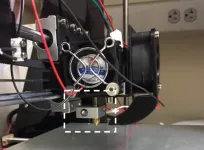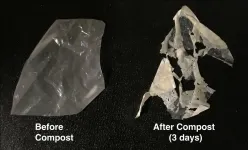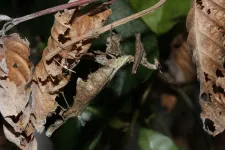(Press-News.org) Washington, DC-- A team of astronomers including Carnegie's Alycia Weinberger and former-Carnegie postdoc Meredith MacGregor, now an assistant professor at the University of Colorado Boulder, spotted an extreme outburst, or flare, from the Sun's nearest neighbor--the star Proxima Centauri.
Their work, which could help guide the search for life beyond our Solar System, is published in The Astrophysical Journal Letters.
Proxima Centauri is a "red dwarf" with about one-eighth the mass of our Sun, which sits just four light-years, or almost 25 trillion miles, from the center of our Solar System and hosts at least two planets, one of which may look something like Earth.
In a worldwide campaign carried out over several months, the researchers observed Proxima Centauri using nine ground- and space-based telescopes. They caught the extreme flare on May 1, 2019, with five telescopes that traced its timing and energy in unprecedented detail.
"The star went from normal to 14,000 times brighter when seen in ultraviolet wavelengths over the span of a few seconds," said MacGregor.
Stellar flares happen when a shift in the star's magnetic field accelerates electrons to speeds approaching that of light. The accelerated electrons interact with the highly charged plasma that makes up most of the star, causing an eruption that produces emission across the entire electromagnetic spectrum.
"Proxima Centauri is of similar age to the Sun, so it's been blasting its planets with high energy flares for billions of years," said Weinberger. "Studying these extreme flares with multiple observatories lets us understand what its planets have endured and how they might have changed."
Like many red dwarfs--the most-common stars in the galaxy and hosts to many of the thousands of known exoplanets--Proxima Centauri is very lively.
"If there was life on the planet nearest to Proxima Centauri, it would have to look very different than anything on Earth," MacGregor said. "A human being on this planet would have a bad time."
To see just how much Proxima Centauri flares, the researchers pulled off what approaches a coup in the field of astrophysics: They pointed nine different instruments at the star for 40 hours over the course of several months in 2019. Those eyes included the the duPont Telescope at Carnegie's Las Campanas Observatory in Chile, the Hubble Space Telescope, the Atacama Large Millimeter Array (ALMA), and NASA's Transiting Exoplanet Survey Satellite (TESS). Five of them recorded the massive May 1 flare from Proxima Centauri, capturing the event as it produced a wide spectrum of radiation. This marked first time astronomers have ever had this kind of multi-wavelength coverage of a stellar flare. Usually, it's considered lucky to get observations from two instruments.
"Now we know these very different observatories operating at very different wavelengths can see the same fast, energetic impulse," Weinberger said.
The technique delivered one of the most in-depth anatomies of a flare from any star in the galaxy. While it didn't produce a lot of visible light, it generated a huge surge in both ultraviolet and radio, or "millimeter," radiation. These signals could help researchers gather more information about how stars generate flares.
They also suggest that there may be more surprises in store from the Sun's "next door" neighbor.
Going forward, "there will probably be even more weird types of flares that demonstrate different types of physics that we haven't thought about before," MacGregor concluded.
INFORMATION:
Arizona State University, NASA Goddard Spaceflight Center, University of Maryland, University of North Carolina at Chapel Hill, University of Sydney, CSIRO Astronomy and Space Science, Space Telescope Science Institute, Johns Hopkins University, the Harvard and Smithsonian Center for Astrophysics, and the University of British Columbia also contributed to this research.
This work was supported by a U.S. National Science Foundation Astronomy and Astro-physics Postdoctoral Fellowship; NRAO Student Observing Support (SOS) grants; a grant from the Space Telescope Science Institute, which is operated by the Association of Universities for Research in Astronomy; and the GSFC Sellers Exoplanet Environments Collaboration (SEEC), which is funded in part by the NASA Planetary Science Divisions Internal Scientist Funding Model.
The Carnegie Institution for Science (carnegiescience.edu) is a private, nonprofit organization headquartered in Washington, D.C., with three research divisions on both coasts. Since its founding in 1902, the Carnegie Institution has been a pioneering force in basic scientific research. Carnegie scientists are leaders in the life and environmental sciences, Earth and planetary science, and astronomy and astrophysics.
A new study published in the Journal of the American Geriatrics Society has found that listening to music can help older adults sleep better.
Researchers from the National Cheng Kung University Hospital in Taiwan combined the results of past studies to understand the effect that listening to music can have on the quality of older adults' sleep. Their work suggests that:
- Older adults (ages 60 and up) living at home sleep better when they listen to music for 30 minutes to one hour at bedtime.
- Calm music improves older adults' sleep quality better than rhythmic music does.
- ...
BUFFALO, N.Y. - 3D printing is transforming everything from fashion and health care to transportation and toys. But this rapidly evolving technology, also known as additive manufacturing, can threaten national security and intellectual property rights.
To reduce illicit use of 3D printers, Zhanpeng Jin, PhD, associate professor in the Department of Computer Science and Engineering at the University at Buffalo, is developing a way to track the origin of 3D-printed items.
His concern was that, as long as people have the digital design for an item, which can be downloaded from the internet, sometimes as open-source material, people can print out anything they want, which can range from computer parts and toys to fully functional handguns and assault rifles.
"So, ...
A fire in Central Park seems to appear as a smoke plume and a line of flames in a satellite image. Colorful lights on Diwali night in India, seen from space, seem to show widespread fireworks activity.
Both images exemplify what a new University of Washington-led study calls "location spoofing." The photos -- created by different people, for different purposes -- are fake but look like genuine images of real places. And with the more sophisticated AI technologies available today, researchers warn that such "deepfake geography" could become a growing problem.
So, using satellite photos of ...
BIRMINGHAM, Ala. - Treatment of an injured or diseased joint may require precise insertion of a syringe needle -- musculoskeletal sonography can help guide clinicians as they drain fluid from arthritic knees or inject corticosteroids into trigger fingers. However, there is a need for training simulators that allow practice on an inert model, before attempting treatment on a patient.
For ultrasound, such simulation trainers are called phantoms.
Researchers at the University of Alabama at Birmingham and University of South Carolina have now made a 3D-printed ...
Decades-old aerial photos of Yudong District, Datong City in Shanxi Province, Northern China have helped researchers in their search for a fault hidden underneath the city's buildings and cement roads, researchers said at the Seismological Society of America (SSA)'s 2021 Annual Meeting.
Analyzing these photos from the 1960s and 1970s allowed Junjie Ren and colleagues to reconstruct a digital elevation model along the Shuiyu fault, helping them identify the fault trace as it passes through Datong City.
Trenching along the revealed fault trace found evidence of ...
Concrete efforts to bring racial equity to the geosciences are receiving significant attention in the wake of new grassroots efforts and increased awareness of social justice issues in 2020, speakers said at the Seismological Society of America (SSA)'s 2021 Annual Meeting.
Last year's Black in Geoscience Week, for instance, began as a grassroots movement to increase representation and raise visibility among Black researchers, as well as to foster networks and connections across the world, said Louisa Brotherson, a leader of the Black in Geoscience group.
The need for community and awareness ...
Ever wondered why your virtual home assistant doesn't understand your questions? Or why your navigation app took you on the side street instead of the highway? In a study published April 21st in the journal iScience, Italian researchers designed a robot that "thinks out loud" so that users can hear its thought process and better understand the robot's motivations and decisions.
"If you were able to hear what the robots are thinking, then the robot might be more trustworthy," says co-author Antonio Chella, describing first author Arianna Pipitone's idea that launched the study at the University of Palermo. "The robots will be easier to understand for ...
Using a novel molecular-data-storage technique, researchers at the University of Texas at Austin have encoded a quote from Jane Austen's classic novel Mansfield Park in a series of oligomers, which a third party could read back without prior knowledge of the structures that encoded the passage. The findings, published April 21st in the journal Cell Reports Physical Science, illustrate a method to encode data that allows for greater information density than DNA-based approaches and that relies on urethane-like plastics--highly accessible and structurally modifiable chemical feedstocks--instead of nucleic acids.
"This work is another step toward the long-term goal of using synthetic sequence-defined polymers for information storage," says Eric Anslyn, a chemistry ...
Biodegradable plastics have been advertised as one solution to the plastic pollution problem bedeviling the world, but today's "compostable" plastic bags, utensils and cup lids don't break down during typical composting and contaminate other recyclable plastics, creating headaches for recyclers. Most compostable plastics, made primarily of the polyester known as polylactic acid, or PLA, end up in landfills and last as long as forever plastics.
University of California, Berkeley, scientists have now invented a way to make these compostable plastics break down more easily, with just heat and water, within a few weeks, solving a problem that has flummoxed the plastics industry and environmentalists.
"People are now prepared to move into biodegradable polymers for single-use ...
It isn't only myriads of currently unknown species that await discovery in the Amazon rainforests. As a new study by German scientists at the Ruhr-University (Bochum) and the Bavarian State Collection of Zoology (Munich), published in the open-access peer-reviewed scientific Journal of Orthoptera Research, concludes, it seems that so do plenty of unusual behaviours.
"When I saw the maggot-like structures peeking out from the back of the praying mantis and then withdrew, I immediately thought of parasites that eat the animal from the inside, because that is not really uncommon in insects," says Frank Glaw, a reptile and amphibian expert from the Bavarian State Collection of Zoology, who discovered ...






